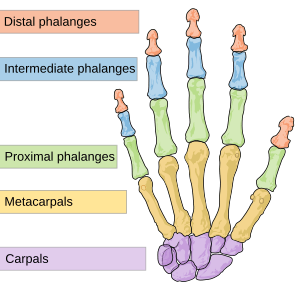Finger facts for kids
A finger is one of the five parts that stick out from your hand. They are also called digits. Our fingers are a lot like those of other primates, like monkeys and apes. We use them for many things, like holding objects, pointing, and feeling different textures.
Humans have five fingers on each hand. The bones inside them are called phalanges. The first and thickest digit is the thumb. After that come the index finger, middle finger, ring finger, and the little finger (sometimes called the 'pinky'). Sometimes, people don't count the thumb as a "finger," but it's definitely a digit of the hand!
Contents
How Your Fingers Work
Finger Bones
Your hand has many bones that work together. The thumb is special because it's on the side of your hand and can move in many directions. This helps you grab things.
The main part of your hand, called the palm, has five bones called metacarpal bones. Each one connects to a finger. Your fingers themselves have 14 smaller bones, which are the phalanges. Your thumb has two phalanges, while your other four fingers each have three. These are the distal phalanx (at the tip, with your nail), the middle phalanx, and the proximal phalanx (closest to your palm).
You also have tiny bones called Sesamoid bones. These are found in tendons, which are like strong cords that connect muscles to bones. They help your fingers move smoothly and protect the tissues underneath.
The places where your bones meet and bend are called joints. In your fingers, you have joints between the phalanges and joints connecting the phalanges to the metacarpal bones in your palm.
Finger Muscles
Your fingers can do many movements: they can bend, straighten, spread apart, and come together. Bending your fingers is usually the strongest movement. You have two main muscles that help each finger bend, plus other smaller muscles that help too. Even though your fingers can move on their own, some of the muscles and tendons are connected, so sometimes moving one finger affects another slightly.
It might surprise you, but your fingers themselves don't have big muscles! The muscles that move your finger joints are actually located in your palm and forearm. You can often see the long tendons (the cords from these muscles) moving under your skin at your wrist and on the back of your hand when you wiggle your fingers.
The muscles that move your fingers are divided into two groups:
- Extrinsic muscles: These are the long muscles in your forearm. They have long tendons that reach all the way to your fingers.
- Intrinsic muscles: These are smaller muscles located right in your hand.
Your fingers have two long bending muscles on the underside of your forearm. Their tendons attach to the different phalanges of your fingers, allowing them to bend. Your thumb has its own special bending muscles, which help it move in a way that lets you grasp objects.
Sensitive Skin
The tips of your fingers are super sensitive! They have the most touch receptors and thermoreceptors (which feel temperature) of any part of your skin. This means your fingertips are excellent at feeling temperature, pressure, vibrations, textures, and even how wet something is. Recent studies even suggest your fingers can feel tiny bumps on a surface that looks smooth! This amazing sensitivity makes your fingers great for exploring the world, but it also means they can get injured easily.
The soft, fleshy part at the very end of your finger, on the palm side, is called the finger pulp.
Why Fingers Wrinkle in Water
Have you ever noticed how your fingertips get wrinkly after being in water for a while? For a long time, people thought this happened because the skin just swelled up. But now we know it's actually caused by your blood vessels getting tighter because your nervous system tells them to when you're in water.
One idea about why this happens is called the "rain tread" hypothesis. It suggests that these wrinkles might help your fingers grip things better when they are wet, just like the treads on a tire help a car grip the road. This could have been helpful for early humans living in forests, dealing with rain and dew. Some studies have supported this idea, showing that wrinkled fingers can indeed grip wet objects better. However, other studies haven't found the same results, so scientists are still learning about it!
Fingers in Other Animals
When we talk about "fingers," we usually mean the digits of primates, like humans and Chimpanzees. Chimpanzees, for example, can use their feet to grab things, and their foot digits are also considered fingers. We don't usually use the word "finger" for the digits of most other animals, like dogs, cats, or hoofed animals. This is because these animals can't use their front paws or hooves for the same kind of detailed tasks that primates can do with their fingers.
Images for kids
See also
 In Spanish: Dedos de la mano para niños
In Spanish: Dedos de la mano para niños




